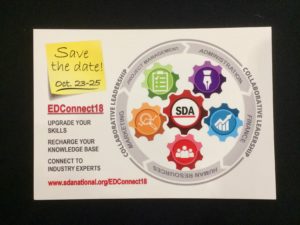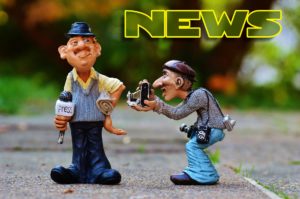 SDA National is at it again! Here comes another EDConnect—a convenient way to get continuing education credits in all things A/E/C. It’s a three-day webinar conference that you and others in your firm won’t want to miss. Stay tuned for more details/registration.
SDA National is at it again! Here comes another EDConnect—a convenient way to get continuing education credits in all things A/E/C. It’s a three-day webinar conference that you and others in your firm won’t want to miss. Stay tuned for more details/registration.
Category Archives: Marketing
A little bit of chuckle is a good thing
 If you think your interview team should be all serious and professional-like in front of the Selection Panel—think again. Well, of course you won’t want to show up in a clown’s suit, and you probably don’t want to launch with a joke, “An architect and an engineer walk into a bar . . .” either.
If you think your interview team should be all serious and professional-like in front of the Selection Panel—think again. Well, of course you won’t want to show up in a clown’s suit, and you probably don’t want to launch with a joke, “An architect and an engineer walk into a bar . . .” either.
According to Scott Johnston, “A little bit of chuckle is a good thing” during your firm’s interview. Especially if you can tie the chuckle into the purpose for you being there. So yeah, you should be professional and serious about presenting, but you should inject some personality while you’re there.
Scott presented “Five Mistakes Selection Panels Say A/E/C Firms Make (and How to Fix Them) at our Seattle chapter’s business practice dinner this month. It was a good session—lots of great tips and examples, including Scott’s answer to the question, “We are the best firm; why do we keep losing?”
The number two mistake firms make? Speaking generally. Scott said that Selection Panels need to hear details.
More according to Scott (whose firm, Johnston Training Group, conducts in-person interviews with selection panel members from numerous public and private organizations, as well as helping A/E/C firms present powerfully):
- Your tone should be humbly competent.
- Pausing is really powerful, and projects confidence.
- Share something personal that relates to the project.
Scott also talked about “creative brief.” Want to know more about that? Feel free to drop Scott a line.
Please, for the love of chimichangas . . .
 make sure you print, proofread, edit, then repeat.
make sure you print, proofread, edit, then repeat.
That’s what we heard from Tammy York (LandShark Communications LLC) in her webinar “How to Get Media Coverage for Your Firm (Press Release 101).”
York has a ton of tips on how to make it easy for a reporter, editor, or influencer to work with you, to “make it easy for them to choose you over the other 947 press releases they received this MORNING!”
And, whether you love chimichangas or not, one thing you want to do is to make sure your press release contains everything you want it to contain to get your announcement, event, promotion, or product published. That means no typos, no fancy fonts, no platitudes, and no clichés. It means thoroughly vetting the 6Ws of a press release: who, what, when, where, why, and how.
So whether you are the copywriter or you’ve hired someone outside the firm to fill that role—be sure you proofread, edit, then repeat—before sending out your press releases.
Own the room as a presenter: Tip #3
 Carla Thompson generated a lot of discussion when she spoke to us about owning the room and not letting the fear of public speaking hold us back from . . . you got it—speaking in public.
Carla Thompson generated a lot of discussion when she spoke to us about owning the room and not letting the fear of public speaking hold us back from . . . you got it—speaking in public.
She shared 9 tricks and tips that can definitely help someone own the room as a presenter, and as a result, be a better, well-prepared public speaker.
It’s not enough just to know the words you are going to speak by heart. (Well, maybe memorization will help if all you have to do is speak from a lectern.) But what if, for example, you were told there is no lectern for you to hide behind? Do you know what you’ll do once you get to the room, knowing there won’t be the one piece of furniture/prop that you hoped there would be?
Carla’s Tip #3: Own the Space
Own the space means that you need to know, ahead of time:
- The layout of the space
- The lighting in the space
- The audio/visual equipment that will be used
- The acoustics of the space
If there’s no lectern, check to see if there’s a table for you to place your notes. If you like to move around while speaking, is there enough space in the room for you to do that, or will you have to watch where you step?
If you know whether the room lighting is bright or on the dark side, you’ll know whether you need a dark or light background on your PowerPoint slides.
If you’re using an unfamiliar laptop or a laptop for the first time, do you know how to show only your slides to your audience and be able to see your speaker notes on the laptop? Do you know how to use the remote to advance your slides?
Will you need a microphone, or is the room small enough for your voice to be heard?
Owning the space means you control your presence during your presentation.
So the next time you find yourself having to speak in front of a group, make sure you have a handle on the space that you’re going to be using during your presentation. If you’re comfortable in the space, it will help you be more comfortable speaking in front of others.
A/E/C Industry Advocates: Get involved!
 What do Peg Staeheli (SvR Design Company), Walter Schacht (Schacht Aslani Architects), and Dave Walsh (Sellen Construction) have in common—besides being well-known advocates for the A/E/C industry? They all believe in the power of participation. They were panelists at our November 19 business practice breakfast, “It’s Bigger Than Us—Behind the Scenes Efforts in Supporting the A/E/C Industry.” In addition to talking about A/E/C policy issues (such as alternative project delivery, environmental regulation, design review reform, urban design, and growth management), they shared their thoughts on being passionate about your field, and getting involved in your field.
What do Peg Staeheli (SvR Design Company), Walter Schacht (Schacht Aslani Architects), and Dave Walsh (Sellen Construction) have in common—besides being well-known advocates for the A/E/C industry? They all believe in the power of participation. They were panelists at our November 19 business practice breakfast, “It’s Bigger Than Us—Behind the Scenes Efforts in Supporting the A/E/C Industry.” In addition to talking about A/E/C policy issues (such as alternative project delivery, environmental regulation, design review reform, urban design, and growth management), they shared their thoughts on being passionate about your field, and getting involved in your field.
- You maintain passion by participating.
- Professional organizations (such as SDA, NAHB, AIA, ASME and WASLA) are a good starting point for developing your passion.
- Participating is your chance to elevate your knowledge and expertise.
- Participating helps you increase your firm’s profile.
- Participating helps you increase your individual profile.
- If you want to be a leader, you need to get involved.
- If you are a leader, you need to jump in.
Helen’s 10 Golden Rules of LinkedIn
 We were thrilled when Helen Pitlick, digital media strategist, spent a Saturday with us going over best practices for enhancing our LinkedIn profiles. Her 10 golden rules of LinkedIn are worth sharing with others. Take a look at these, and then take a look at your LinkedIn profile. Do you need to modify anything? Continue reading
We were thrilled when Helen Pitlick, digital media strategist, spent a Saturday with us going over best practices for enhancing our LinkedIn profiles. Her 10 golden rules of LinkedIn are worth sharing with others. Take a look at these, and then take a look at your LinkedIn profile. Do you need to modify anything? Continue reading
Should you fire your bad client?
 Fire your bad client? Whoa, that sounds drastic! Why would you want to get rid of a client? June R. Jewell, CPA, President & CEO of AEC Business Solutions has done just that. Why? It’s one of 3 steps that can help you increase your fees. Read her blog post here.
Fire your bad client? Whoa, that sounds drastic! Why would you want to get rid of a client? June R. Jewell, CPA, President & CEO of AEC Business Solutions has done just that. Why? It’s one of 3 steps that can help you increase your fees. Read her blog post here.
Free on-line stock photos, really!
 We were stoked to come across an article by Casey Ark (CEO of Plato) in which he shares a list of “14 Amazingly Free Stock Photo Websites,” (Entrepreneur, October 20, 2014).
We were stoked to come across an article by Casey Ark (CEO of Plato) in which he shares a list of “14 Amazingly Free Stock Photo Websites,” (Entrepreneur, October 20, 2014).
Who doesn’t need that list (especially when marketing budgets are slim)? Case in point: The (free, no attribution required) photo attached to this post is from Pixabay, from a simple search on “architecture.”
Thank you, Casey! Read the article here.
Raster? Vector? Say what?
If your repro firm asks you for a raster file, will you know what to send? What if the printer asks you for a vector file?
Leave it to Matt Virkler (knowledge manager at DLR Group) to tell you what you need to know. He presented a webinar for us on the types and uses of imagery.
- If your printer asks you for a raster file, send over a tiff, jpeg, or bmp file.
- If your printer asks you for a vector file, send over an ai, svg, or eps file.
SDA member Penny Nelson liked Matt’s “ability to switch into a web browser to show us how to search for images.” Member Lois Diemert said, “Matt’s presentation was exactly the information I was looking for to better understand the basics of working with images.”
Great presentation, Matt; thanks!
In viz-time: Project designs that will knock your socks off!
Remember back in the day when drafters took pencil to paper on drafting tables and drew up the plans that engineers and architects used to build their project? We’ve come a long way baby! Steve Johnson (senior design visualization specialist at Parsons Brinckerhoff) presented a business practice webinar demonstrating the cool simulations he and his colleagues have designed, and what many clients are now requesting in the way of deliverables or work products. These are hot video simulations that are visually awesome.
Just take a look at this simulation. It’s a historical build-up of the Seattle skyline showing 50 years of building development—from 1958 to 2008 (from Parson Brinckerhoff’s 3D model of the city).




You must be logged in to post a comment.